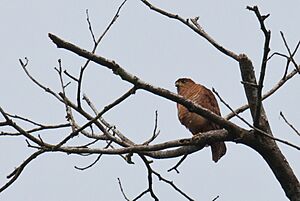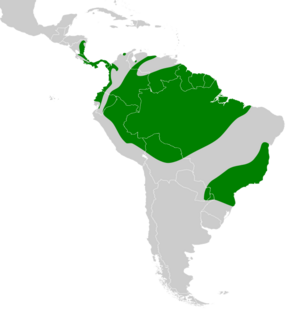Tiny hawk facts for kids
Quick facts for kids Tiny hawk |
|
|---|---|
 |
|
| Conservation status | |
| Scientific classification | |
| Genus: |
Microspizias
|
| Species: |
superciliosus
|
| Subspecies | |
|
|
 |
|
| Synonyms | |
|
Falco superciliosus Linnaeus, 1766 |
|
The tiny hawk (Microspizias superciliosus) is a small bird of prey. It lives in forests, mostly in warm, wet areas of Central and South America. This hawk hunts during the day. It mainly eats other birds, and it's even known to catch hummingbirds!
Contents
About the Tiny Hawk's Name
The tiny hawk was first officially described in 1766. A Swedish scientist named Carl Linnaeus gave it the scientific name Falco superciliosus. Linnaeus is famous for creating the system we use to name all living things. The name superciliosus comes from Latin and means "eye-browed."
There are two main types, or subspecies, of tiny hawks. They live in different areas, separated by the Andes mountains. These two types look very similar. Their main difference is how long their tails are.
- M. s. superciliosus lives east of the Andes in South America. This type is a bit larger and has lighter, grayish stripes on its belly.
- M. s. fontanieri lives from Nicaragua down to western Ecuador. It is slightly smaller and darker. It has a shorter tail and sharper, blacker stripes underneath.
Scientists have studied the tiny hawk's body and DNA. They found that it's quite different from other hawks in the Accipiter group. Because of these differences, scientists decided to give it and a related hawk a new group name. In 2021, they were moved into a new genus called Microspizias.
What Does a Tiny Hawk Look Like?
The tiny hawk truly lives up to its name! Males are about 20 centimeters (8 inches) long. This is about the size of a European starling. Females are a bit larger, growing up to 26.5 centimeters (10.5 inches).
It is one of the smallest true birds of prey in the world. It weighs between 75 and 120 grams (2.6 to 4.2 ounces). Female tiny hawks are much bigger than males. They can be up to 25% longer and 60% heavier. This difference in size between males and females is called sexual dimorphism.
Adult male tiny hawks are dark gray on their backs. Their faces are mottled gray, with a lighter gray stripe above their eyes. Their head and neck are blackish. Their white undersides have fine gray stripes, except for their plain white throat. Their tail is longish, dark, and has three lighter gray bands.
Adult females look similar but are browner on top. Their undersides are more buff-colored with browner stripes. All tiny hawks have yellow skin around their beak (called a cere) and yellow legs. Their beak is strong and gray. Adult hawks have red or reddish-brown eyes. Young hawks often have yellowish eyes.
Unlike most hawks, the tiny hawk has a short tail. Its tail is either square or slightly notched at the end. Its wings are medium-sized with pointed tips. Its legs and toes are long.
Young tiny hawks come in two different colors. Some are brown, and some are reddish-brown (rufous). Brown young hawks are dark sooty-brown on their backs. They have fine black stripes. Their white undersides have strong cinnamon-colored stripes. Rufous young hawks are more chestnut-colored on top. Their undersides have reddish-brown stripes. They also have darker heads and brighter reddish-brown tails than the brown ones.
The tiny hawk's call is a high-pitched, shaky sound. It has 20 to 30 notes that change pitch. The call starts fast, then settles into a steady rhythm. People describe it as caucau-ca-ca-ca or keer-keer-keer.
Where Tiny Hawks Live
Tiny hawks are found in specific areas. They live from eastern Nicaragua down to western Ecuador. You can also find them in northern Bolivia, northern Argentina, Paraguay, and southern Brazil.
They prefer wet lowland forests. This includes forests that are growing back after being cut down. They also live in forested foothills. You can find them from sea level up to about 1800 meters (5900 feet). However, most tiny hawks are seen below 1000 meters (3300 feet). Scientists believe these birds usually stay in one area and do not travel far.
Tiny Hawk Behavior
On clear mornings, and sometimes in the late afternoon, tiny hawks like to sunbathe. They will sit on a high, open branch. Sometimes, a pair of hawks will sunbathe together. Other than that, these birds are quite shy and hard to spot.
They usually hunt from a perch. This perch can be anywhere from low bushes to the top of the trees. Most often, they hunt from the middle part of the forest. When hunting in low areas, they often fly quickly from one perch to another.
Tiny hawks are fast flyers. They flap their wings a few times quickly, then briefly close them before flapping again. This is different from how many other hawks fly. Sometimes, tiny hawks will soar high above the forest trees.
What Tiny Hawks Eat
Like all hawks in their family, tiny hawks mainly eat other birds. They hunt hummingbirds and small passerines (songbirds). They often dart out from a hidden spot to catch birds as they fly by. They also surprise smaller birds when they are sitting on a branch.
There is some evidence that tiny hawks learn where certain hummingbirds regularly perch. Then, they go there to hunt them. However, they don't only eat hummingbirds. Some tiny hawks also hunt rodents and bats.
Tiny Hawk Life Cycle
Not much is known about how tiny hawks reproduce. Their breeding season might change depending on where they live. In places like Panama and Colombia, it seems to be from February to June. In the southern parts of their range, it might be from October to January.
They build nests out of sticks. These nests are sometimes built high up in tall trees. In Venezuela, one pair was seen nesting in an old nest that belonged to a black-collared hawk. Female tiny hawks lay one to three bluish-white eggs. These eggs have faint brown streaks and spots. We don't know how long the eggs take to hatch or how long it takes for the young birds to leave the nest.


